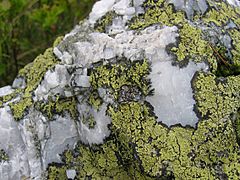Map lichen facts for kids
Quick facts for kids Rhizocarpon geographicum |
|
|---|---|
 |
|
| Scientific classification | |
| Kingdom: | |
| Division: | |
| Class: |
Lecanoromycetes
|
| Order: |
Lecanorales
|
| Family: |
Rhizocarpaceae
|
| Genus: |
Rhizocarpon
|
| Species: |
R. geographicum
|
| Binomial name | |
| Rhizocarpon geographicum |
|
The map lichen (scientific name: Rhizocarpon geographicum) is a special type of lichen. It gets its name because it looks like a map or a patchwork field. You can often find it growing on rocks in places where the air is clean.
Each map lichen looks like a flat patch. It has a black line around its edges, made of spores. These patches often grow right next to each other. This creates the cool map-like pattern you see.
Contents
What is Map Lichen?
Map lichen is a species of lichen that grows on rocks. It prefers areas with low air pollution. The patches are usually flat and have a distinct black border. When many patches grow together, they create a pattern that looks like a map. This is how the lichen got its common name.
How Map Lichen Helps Scientists
Scientists called climatologists use map lichen a lot. They use it to figure out how old certain rock deposits are. For example, they can study rocks left behind by glaciers. This helps them understand how long a rock has been uncovered. It also helps them learn about past glacial movements. This method is called lichenometry.
What is Lichenometry?
Lichenometry is a way to tell the age of rocks or surfaces. It works by looking at the largest lichen growing on a rock. Scientists assume that the biggest lichen is also the oldest one. If they know how fast a lichen grows, they can guess how long the rock has been there. This gives them a minimum age for when the rock was placed or exposed.
Measuring Growth Rates
To use lichenometry, scientists need to know how fast lichens grow. They find this out by measuring lichens on things of a known age.
- Gravestones: They might measure lichens on old gravestones with dates on them.
- Old Buildings: Historic or prehistoric rock buildings also have known ages.
- Moraines: These are piles of rocks left by glaciers. Some moraines have a known age, like those from the Little Ice Age.
By studying lichens on these known-age surfaces, scientists can create growth rate charts. These charts help them estimate the age of other rocks.
See also
 In Spanish: Liquen geográfico para niños
In Spanish: Liquen geográfico para niños

